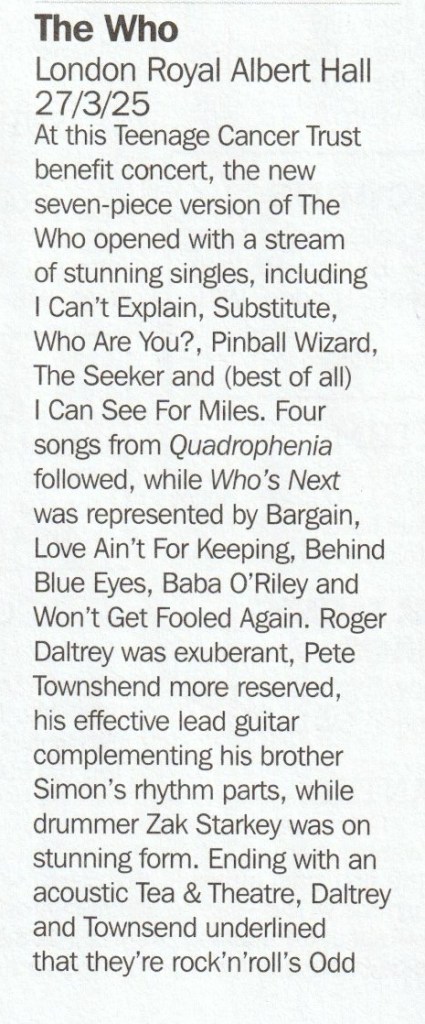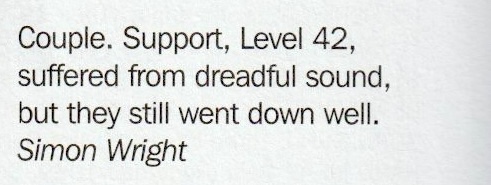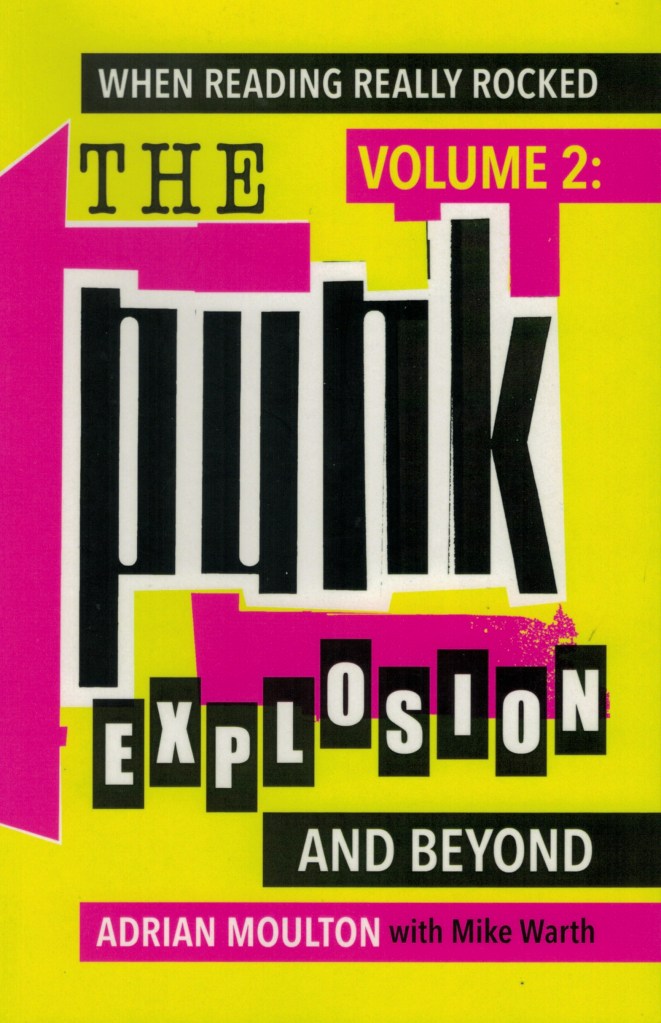
This slim paperback was given to me by Nick Duckett, who appears consistently throughout the book as performer, promoter, venue owner, journalist, record shop owner, record label proprietor and all-round alternative svengali for the punk and post-punk Reading scene. Which this book covers with enthusiasm and affection, whether its debating the attractions of legendary venues such as Bones or The Target or detailing the history of local bands such as the K9’s, General Accident and The Complaints. Authors Adrian Moulton and Mike Warth have done a fine job, starting in 1977 and coming more or less up to date. Pages 24-26 cover my own band Trash, who receive a sympathetic profile. The book is published by Two Rivers Press (http://www.tworiverspress.com) and retails for £12.99.
Available from http://www.1960s.london
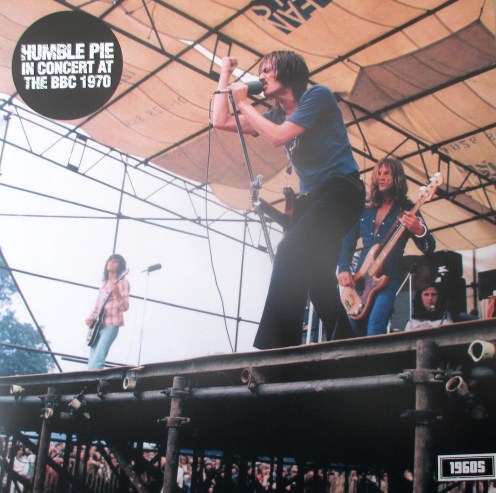
Humble Pie – In Concert At The BBC 1970
Tracklisting
Side One
- Four Day Creep (Cox)
- I’m Ready (Ridley, Marriott, Shirley, Frampton, Dixon)
- Live With Me (Ridley, Marriott, Shirley, Frampton)
- Stone Cold Fever (Ridley, Marriott, Shirley, Frampton)
Side Two
- Hallelujah I Love Her So (Charles)
- I Walk On Gilded Splinters (Creaux)
- The Sad Bag Of Shakey Jake (Marriott)
Recording Details
All tracks recorded for BBC Radio ‘In Concert’ at The Paris Theatre, Lower Regent Street, London on September 10th 1970 and transmitted on September 20th
Personnel
Steve Marriott – Vocals, guitar, harmonica
Peter Frampton – Vocals, guitar, organ
Greg Ridley – Bass, vocals
Jerry Shirley – Drums
Recording Quality
Excellent throughout
Sleevenotes
“In their prime Humble Pie were considered to be one of the greatest live acts in the world. They never quite captured the energy and excitement on record, and thus got left behind in the Great British Rock Boom of the late 60’s and early 60’s. Yet Humble Pie bestrode the era with a confidence and swagger that few could match.”
Mick Wall (2024)
Live At the BBC 1969 (R&B149) documented Humble Pie’s first year when they released two LPs on Immediate Records, As Safe As Yesterday Is (August) and Town And Country (November). Neither LP sold well. These records highlighted the contrast between the reticent and laidback Peter Frampton and the more upfront Steve Marriott. By 1970 this balance had shifted. Immediate had gone bust, so the band signed to A&M and acquired a heavyweight new manager in Dee Anthony. Anthony pushed the band towards a more raucous style, which they would refine on extensive American tours. Talking to John Pidgeon, Marriott remembered that “America sorted me out. As soon as I began to rouse audiences a bit, it began to slowly come back and I realised what we had to do and how we could do it. It was lovely, a good feeling. Poor Pete suffered because I suddenly began to take giant steps. I felt sorry for him at that particular time because I could see it in him onstage – I was just swamping him. And he didn’t know what had happened, because when we first formed I was much more in the background and quiet. It was suddenly like I’d taken over the whole stage which was something I couldn’t help but do, because when my confidence came back, it came back with an almighty bang.” Frampton remembers a discussion with producer Glyn Johns ahead of sessions for the band’s third LP (Humble Pie, July 1970). “Glyn said ‘I think you ought to look at your direction. Steve’s the singer, Pete’s the lead guitarist, Greg’s the bass player and Jerry’s the drummer – how’s that?’. And he was right. It was about how to channel our strengths. We all sang a little bit but we relinquished the singing to Steve. No one had a problem with this because it was such an honour to be in a band with someone who had a voice like that.”
John Peel was an early champion of the band, introducing this Sunday Concert with
“just one band for you, but an excellent band they are too”. Set-opener Four Day Creep never appeared on a Humble Pie studio album. The song was written by Jessie Crump and first released by Ida Cox in 1927: the main riff is played in unison by both Frampton and Marriott. I’m Ready was originally written by Willie Dixon for Muddy Waters and whilst his lyrics are retained, the music is completely rewritten earning a band composition credit. Peel introduces Live With Me as having a “great rock-solid rolling forward feeling”, comparing it to The Band – unsurprising as Music From Big Pink had been the initial blueprint for Humble Pie. A slower-paced number, it features Frampton on Hammond organ which allows for some extended soloing. Stone Cold Fever would not appear on record until album number four, 1971’s Rock On. The song’s basic riff was written by Frampton and it would become a mainstay of the band’s live set.
Hallelujah I Love Her So is a swaggering showcase for Marriot’s ability to channel his favourite singers, here Ray Charles. Again talking to John Pidgeon, Marriott admittedthat onstage he seemed to completely forget he was a white kid from Bow. “I’ve seen a video of us playing and it shocks me. It’s like hearing another person coming through. In the States they regard me as a freak – a tiny little geezer who’s got a very big voice. I don’t know what makes me sing that way. It took me a long time to control it.” In New York Jerry and Peter met Dr John, composer of I Walk On Gilded Splinters. Frampton: “He said ‘I just love you guys. And you know why? Cos I was in jail when you did that song of mine. With the money I got from that I hired myself a much better lawyer and got out quick. You guys got me out of jail!’ ”. The extended version here allows for a bass solo from Greg and harmonica from Steve. Finally a succinct The Sad Bag Of Shakey Jake features a return to the semi-acoustic Pie and a semi-country vocal from Steve.
Looking back, Jerry Shirley is rueful. “The band had potential to be one of the true greats, but did not achieve anywhere close to what they could have done, other than on stage.” We are fortunate that the BBC were on hand to document this Performance (Rockin’ The Paris).
Sleevenotes: S. ‘Moe’ King
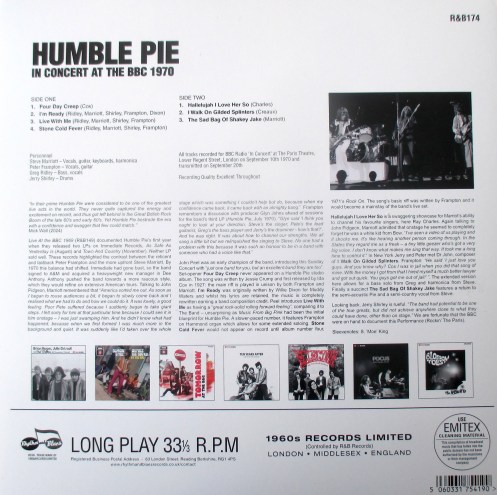
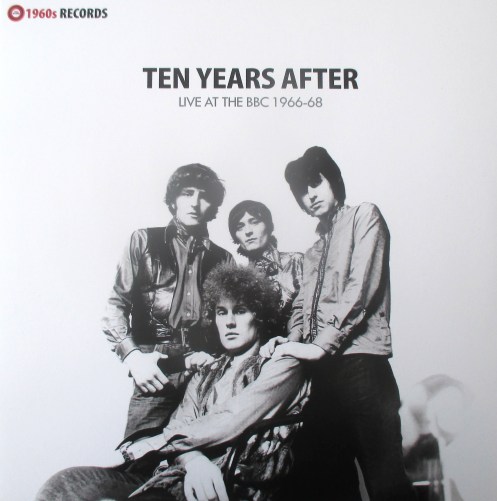
Ten Years After
Live At The BBC 1966 – 1968
Tracklisting
Side One
- Love Until I Die
- Don’t Want You Woman
- Sometimes I Feel Like Going Home
- I Ain’t Seen No Whiskey (Williams)
- Rock Your Mama
- Portable People
- I May Be Wrong But I Won’t Be Always (Lee, Churchill, Lyons, Leo)
Side Two
- Woman Trouble
- No Title Blues
- I’m Going Home
- Get Out Of My Life Woman (Toussaint)
- Yes It’s Me (Domino, Bartholemew)
- My World Fell Down (Carter, Stephens)
All songs written by Alvin Lee except where noted
Personnel
Alvin Lee – guitar, vocals, harmonica
Chick Churchill – organ
Ric Lee – drums
Leo Lyons – bass
The Ivy League – vocals (Side Two, Track 6)
Recording Details
All tracks recorded for BBC radio as follows:
Side One
Tracks 1-3 recorded for Top Gear on 12.10.67, broadcast on 21.11.67
Tracks 4-7 recorded for Top Gear on 13.3.68, broadcast on 7.4.68
Side Two
Tracks 1 – 3 recorded for Top Gear on 14.8.68, broadcast on 18.8.68
Track 4 broadcast on 11.3.66
Tracks 5 & 6 broadcast on 17.10.66
Sleevenotes
“They’re from England and they made their US debut in 1968 (the year all the British blues bands arrived). They describe their sound as progressive blues but it contains a lot of boogie and Count Basie. Instead of coming on hot and hard like the blues-influenced bands (Cream, Canned Heat) the group projects a sound that is light and fast and easy, which is not to say lightweight.” Lillian Roxon, Rock Encyclopedia
After listening to Charlie Christian, the twelve-year old Alvin Lee switched from learning clarinet to guitar. His mother Doris recalled “he practiced every minute he could and got on with it like crazy, so quickly we knew the talent was there and nothing could stop him.” In 1957 he joined Vince Marshall and the Square Caps, followed by Alan Upton and the Jail-Breakers (1958) and then in 1960 Ivan Jay and the Jaymen, where Lee first encountered bass player Leo Lyons and drummer Ric Lee. All these bands were based in the Nottingham / Mansfield area. Ivan Jay and the Jaymen became The Jaybirds and moved to London in 1966 which is when keyboards player Chick Churchill joined the band. Initially The Jaybirds provided backing to vocal trio group The Ivy League, recording instrumental tracks for the BBC such as Get Out Of My Life Woman (Lee Dorsey) and Yes It’s Me (Little Richard). Ivy League member John Carter wrote My World Fell Down with Geoff Stephens: the version presented here is a perfect combination of harmony vocals and beat-group backing. The song would later be recorded by Gary Usher and Curt Boettcher and released as a single under the name Sagittarius, a highlight of Lenny Kaye’s original Nuggets compilation (1972).
The Jaybirds then became Blues Trip and Blues Yard before settling on Ten Years After. John Peel was an early supporter, as he explained to Michael Watts of the Melody Maker in1971. “Now the first time I saw Ten Years After was when I went to the Roundhouse with Andy Roberts, and we came back and I felt the same way as I had done with Duane Eddy. I was really knocked out, because there were all these grubby lads from Leicester, or wherever it was, and Alvin Lee’s playing was just great, incredible to listen to. Flash, but there’s nothing wring with being flash if you mean it.”
From the band’s first Top Gear session, Love Until I Die is taken from their self-titled debut LP (1967) and built around a Crossroads-style riff. Also from the debut LP is the acoustic Don’t Want You Woman, a tale of female perfidy with a lively, foot-tapping beat and some tasty guitar picking. Sometimes I Feel Like Going Home never appeared on a Ten Years After studio LP: starting with the words “I woke up this morning” suggests a 12-bar blues which is delivered, complete with some fluid Alvin Lee guitar. Also studio-unreleased is the band’s cover of I Aint’ Seen No Whiskey with some effective organ from Churchill. Rock Your Mama would not see a studio release until the compilation Alvin Lee & Company in 1972: it is another blues number with a tough-sounding vocal from Alvin. A complete contrast is Portable People. Released as a stand-alone single in 1968, here keyboard sounds and acoustic guitar support a lyric that veers uneasily from attempted social comment (“they’re the jet age gypsies with a super-sonic sound”) to Dylan-style non-sequiturs (“he liked the avocado, but he didn’t like the vase”). It was not a hit. I May Be Wrong But I Won’t Be Always takes its inspiration and title from the Count Basie song of the same name: the jazzy arrangement emphasises the strength of the rhythm section and encourages Alvin Lee and Churchill to solo before Leo takes a bass showcase, backed by Ric Lee’s energetic drumming.
Side two starts with Woman Trouble, a track from the Stonedhenge LP (1969). Another swinging number which highlights the band’s strengths with Churchill playing a bluesy organ solo and Alvin Lee showing great restraint and fluid fingers. Another track from Stonedhenge, No Title Blues suggests that the LP title was more than a play on words and that the horizons of the group were being chemically advanced. Alvin Lee’s funereal vocal sets a sombre mood, dispelled by a lengthy Hammer Horror-style organ solo, finishing with a restatement of the song’s heavy riff.
Which just leaves I’m Going Home. The song was first recorded on the band’s second LP, the live at Klooks Kleek Undead (1968). An eleven minute version would feature prominently in the Woodstock film (1970). This version recorded for Top Gear in August 1968 showcases a band full of freshness and enthusiasm, happy to engage in a hell-for-leather dash through a song where the lyrics rivalled the Ramones for complexity. The song is a showcase for Alvin Lee’s speed and dexterity as a guitarist but would end up defining the group in the years ahead and sidelining the band’s jazz and blues influences in favour of endless boogie. As Alvin told Hugh Fielder “You’d walk on stage and people would be shouting for I’m Going Home, which was the last song. I often wonder what the rest of our career would have been like if the Woodstock movie had used another song. As it was, everything became focused on the last song, the high-energy number.” As we have seen, there was much more to Ten Years After than this.
Sleevenotes: Captain Speedfingers


BBC Broadcasts 1966-68
Brian Auger, Julie Driscoll and The Trinity
Tracklisting
Side One
- This Wheel’s On Fire (Dylan, Danko)
- A Kind Of Love-In (Auger, Driscoll)
- Shadows Of You (Auger, Driscoll)
- Why (Am I Treated So Bad) (Staples)
- Don’t Let Me Be Misunderstood (Benjamin, Caldwell, Marcus)
- Interview
Side Two
- Season Of The Witch (Leitch)
- The Road To Cairo (Ackles)
- I Am A Lonesome Hobo (Dylan)
- Old Jim Crow (Alper, Simone, Groef)
- I’m Not Talkin’ (Allison)
- Shadows Of You (Auger, Driscoll)
Personnel
Brian Auger – keyboards, vocals
Rick Laird – bass
Dave Ambrose – bass
Phil Kinorra – drums
Clive Thacker – drums
Vic Briggs – guitar
Gary Boyle – guitar
Julie ‘Jools’ Driscoll – vocals
Recording Details
All tracks recorded specially for the BBC 1966-1968
Sound Quality
Excellent throughout
Sleevenotes
“The cleverest thing Julie Driscoll ever did was to get her Mum to perm her hair. Although it was one of those dreadful home permanents – Julie’s hair frizzed out as though each individual hair had been struck by lightning, a huge freaky halo of electricity around her head – it was the most miraculous transformation since Bob Dylan and Jimi Hendrix let their hair grow. She got one whole page in Vogue for her hair and another for her star eye make-up. As for Brian Auger and The Trinity they are always complaining about being upstaged by ‘Jools’. Maybe they should get their Mums to perm their hair too.”
Lillian Roxon’s Rock Encyclopaedia (1969)
Our previous release R&B122 documented how manager Georgio Gomelsky augumented jazz combo The Brian Auger Trinity with singers Rod Stewart, Long John Baldry and Julie Driscoll to form the R&B /soul revue Steampacket. Stewart, Baldry and Driscoll left Steampacket in Autumn 1966, leaving the band as Brian Auger and The Trinity. This line-up released two unsuccessful singles before Julie Driscoll returned for the November 1967 single Save Me (Parts 1 & 2), released under the rather unwieldy name of Brian Auger, Julie Driscoll and The Trinity. This was not a hit but the follow up, This Wheel’s On Fire (April 1968), reached number 5 in the UK charts, number 13 in Canada and charted throughout Europe. Originally written by Bob Dylan (lyrics) and The Band’s Rick Danko (music) Auger gave the song a completely new arrangement featuring a delicate piano introduction, phasing, Mellotron, Hammond organ and distortion to echo the apocalyptic lyric. The unconventional music was complemented by ‘Jools’ striking looks, her vivid dress-sense and mesmerising vocals. The result was one of the most enigmatic singles of the 1960s which retains an air of mystery even today. The version recorded for the BBC loses nothing in live performance. The song would reach new audiences when recorded by Siouxsie and the Banshees in 1987 and used as the theme tune for TV comedy Absolutely Fabulous in the early 1990’s. Auger is scathing about the latter. “They didn’t even use the original version. They were so cheap they paid Julie a miniscule fee to re-record the vocal with session musicians.”
A Kind Of Love-In and Shadows Of You were both Auger/Driscoll compositions, appearing on single B sides and featuring Auger’s Hammond extensively. Roebuck “Pop” Staples wrote Why (Am I Treated So Bad). Far from being a romantic complaint, the song is about The Little Rock Nine, the first black students to attend the segregated Little Rock Central High School. In 1957 it took three weeks and an escort of federal troops organised by President Eisenhower before The Little Rock Nine were allowed to enter the previously all-white school in Arkansas. Don’t Let Me Be Misunderstood is performed as a slow, soulful duet which pays respect to Nina Simone’s version. The interview that follows features Jools and Brian interrogated by the inevitable Brian Mathews.
Donovan’s Season Of The Witch was a single throughout Europe and pits an impassioned Driscoll vocal against Auger’s keyboards. The Road To Cairo was the follow-up to This Wheel’s On Fire and although it did not duplicate that record’s commercial success it showed the band’s ability to spot promising songwriters such as David Ackles. A further Dylan cover is I Am A Lonesome Hobo, here given an upbeat arrangement that would have got any ex-mods up and dancing. Auger provides a jazzy backing to Nina Simone’s Old Jim Crow, her attack on the state and local laws passed in the American South to enforce racial segregation. Another one of Gomelsky’s bands The Yardbirds had released a raunchy version of Mose Allison’s I’m Not Talkin’ in 1965 on their Five Yardbirds EP and the same year Auger had played the harpsichord on their hit single For Your Love. The Trinity version of I’m Not Talkin’ is sung by Auger and lacks the yobbo raunch of the Yardbirds version, putting more emphasis on the lyrics. Finally a second version of Shadows Of You, this one with a nimble-fingered guitar solo.
That’s all for now. Brian Auger, Julie Driscoll and The Trinity recorded even more tracks for the BBC so you know we shall meet again (if your memory serves you well).
Sleevenotes:
Ma ‘Mel’ Layed

Available from http://www.1960s.london
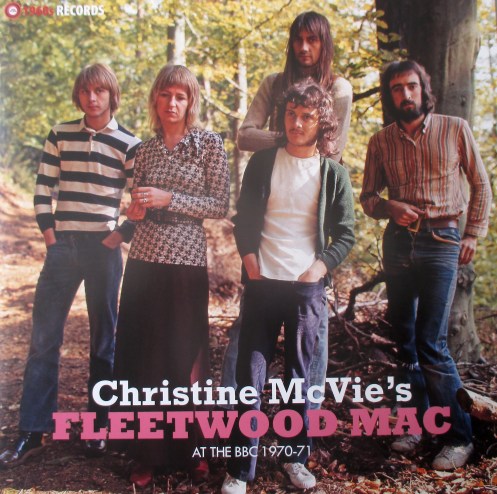
Live On Radio and TV 1970 – 71
Fleetwood Mac
Tracklisting
Side One
- Crazy ‘Bout You Baby (Jacob)
- Down At The Crown For Now (Kirwan)
- Tell Me All The Things You Do (Kirwan)
- Station Man (Kirwan, Spencer, John McVie)
- Dragonfly (Kirwan, Davies)
- Start Again (Christine McVie)
- Preachin’ Blues (House)
Side Two
- Purple Dancer (Kirwan, Fleetwood, John McVie)
- Down At The Crown For Now (Kirwan)
- Get Like You Used To Be (Webb, Perfect)
- Dragonfly (Kirwan, Davies)
- Station Man (Kirwan, Spencer, John McVie)
- One Sunny Day (Kirwan
- When The Train Comes Back (Perfect)
- I Believe My Time Ain’t Long (Johnson)
- Teenage Darling (Spencer)
Recording Details
Side One
Tracks 1 – 3 recorded for BBC Radio 1 Club on November 10th 1970, transmitted on December 14th
Track 4 recorded for BBC Radio Sounds Of The Seventies on November 24th 1970 and broadcast on December 1st
Tracks 5 – 7 recorded for BBC radio Top Gear on January 5th 1971, transmitted on January 23rd (Tracks 6 & 7) and March 27th (Track 5)
Side Two
Tracks 1 & 2 recorded for BBC Radio Sounds Of The Seventies on November 24th 1970 and broadcast on December 1st
Track 3 recorded for BBC radio Top Gear on January 5th 1971, transmitted on January 23rd
Track 4 Recorded for German TV Beat Club at Radio Bremen, June 26th 1971
Tracks 5 – 8 Recorded for the TV documentary Black And White Blues in 1970, transmitted in 1971
Track 9 recorded for BBC radio Top Gear on January 5th 1971, transmitted on January 23rd
Sound Quality
All tracks are Excellent except on Side Two where tracks 2 and 5-7 are Very Good and tracks 3, 8 and 9 are Good but still very listenable.
Personnel
Danny Kirwan – guitar, vocals
Jeremy Spencer – guitars, maracas, vocals (except Side Two, Track 4)
John McVie – bass
Mick Fleetwood – drums
Christine McVie – piano, vocals
Bob Welch – guitar (Side Two, Track 4)
Sleevenotes
By the time these tracks were recorded Fleetwood Mac were highly successful, renowned internationally for both releasing hit singles and performing exhilarating live gigs. However they were also without lead guitarist and songwriter Peter Green, who had become thoroughly destabilised after a bad trip during a German tour. Peter played his last gig on May 20th 1970.
What happened next was Kiln House, a converted oast house in Hampshire. The band lived there communally with their families for a six-month period with Kiln House also becoming the title of their next LP, released in September 1970. By now bass player John McVie had married Christine Perfect, formally the lead singer with Chicken Shack. Christine provided (uncredited) keyboards and backing vocals on Kiln House before joining the band in time for their November 1970 BBC sessions. Station Man was the centrepiece of Kiln Houseand this version features extensive guitar interplay between Kirwan and Spencer with Christine McVie’s vocals and electric piano adding a new element. Purple Dancer was frequently played live but would never make it on to a studio LP despite its excellent blend of slide quitar and vocal harmonies. There is more fine slide on Danny Kirwan’s Down At The Crown For Now. Little Walter’s Crazy ‘Bout You Baby was originally recorded by Christine Perfect on her eponymous 1970 solo LP, it is also known as Can’t Hold Out Much Longer. With her taking the lead vocal and an uptempo arrangement it proves a good fit for this incarnation of Fleetwood Mac. A second version of Down At The Crown For Now features an echo-laden guitar solo. There is some uncertainty as to whether the version of Tell Me All The Things You Do was actually broadcast. Another Kirwan song from Kiln House it once again features excellent twin guitar parts.
Black And White Blues was a 1970 TV documentary that allowed disgruntled US blues artists to air their grievances about being exploited musically and financially. As part of the programme four song fragments were recorded by Fleetwood Mac in the music room of either Kiln House or its successor. I Believe My Time Ain’t Long was the very first Fleetwood Mac single. Jeremy Spencer optimistically clamed a writing credit (as “G.Spence”) but the song is actually Dust My Broom by Elmore James, written by Robert Johnson. Danny’s Sunny Day was released on Then Play On,here his Flying V combines well with Christine’s keyboards. This version of Station Man features Spencer on slide and more of a groove. Christine originally recorded When The Train Comes Back with Chicken Shack: the solo version here frames her melancholy vocals with more slide guitar. Get Like You Used To Be is another Chicken Shack number, here recorded for the BBC in early 1971. Christine’s piano is prominent as the band take the song at a relaxed shuffle, allowing plenty of space for guitar solos and unison vocals. Dragonfly is the great lost Fleetwood Mac single. A poem by WH Davies set to music by Kirwan it has a gentle evocative melody and deserved to be a hit but the release failed to chart anywhere in the world. Teenage Darling is one of Spencer’s classic fifties cover versions, except that he wrote it himself – it was released as the B-side of his single Linda. The spoken interlude and backing vocals positively drip with grease. From the same BBC session comes a solo Jeremy Spencer cover of Son House’s Preachin’ Blues which highlightshis exemplary slide guitar. Christine’s Start Again would appear on the next Fleetwod Mac LP Future Games (September 1971), re-titled as Morning Rain. Another highly melodic number it suggested a new direction for the band: less guitar pyrotechnics, more keyboard- and vocal-driven melodies.
Fleetwood Mac had thus successfully reinvented themselves, overcoming the loss of Peter Green and finding in Christine McVie someone who could help them forge a new musical direction. This new-found stability was threatened during a tour of the US in February 1971 when Jeremy Spencer decided to join the religious sect The Children Of God. His short-term replacement was a returning Peter Green. His permanent replacement was US guitarist Bob Welch, who can be seen in the performance of Dragonfly from Beat Club in June 1971. Despite eye-wrenching “psychedelic” effects this specially recorded track benefits from Fleetwood’s restrained percussion and Danny’s closing solo, making the song a worthy successor to Albatross. Welch would stay with Fleetwood Mac for five years during which time he would encourage the band to move to the US, where they would encounter an unsuccessful songwriting duo named Buckingham Nicks. Fleetwood Mac would once again metamorphise, this time achieving commercial success on an unprecedented scale.
Sleevenotes: Ben I. Folds


Christine Perfect’s Chicken Shack
Live At The BBC 1968 – 69
Tracklisting
Side One
- I’d Rather Go Blind (James, Jordan, Foster)
- Hey Baby (Perfect, Vernon, Webb)
- No Road Is The Right Road (Perfect)
- Get Like You Used To Be (Perfect, Webb)
- It’s OK With Me Baby (Perfect)
- When The Train Comes Back (Perfect)
- Mean Old World (Jacobs)
- Love Me Or Leave Me (Mayfield)
- Interview
Side Two
- No Road Is The Right Road (Perfect)
- With Pen In Hand (Goldsboro)
- When You Say (Kirwan)
- Hey Baby (Perfect, Vernon, Webb)
- It’s You I Miss (Perfect)
- Gone Into The Sun (Perfect)
- Side Tracked (King, Thompson)
- Night Life (Buskirk, Breeland, Nelson)
- Interview
Recording Details
All tracks recorded for BBC Radio:
Side One
Tracks 1 & 2 for Symonds On Sunday April 14th 1969, transmitted April 20th
Tracks 3 & 4 for Symonds On Sunday January 27th 1969, transmitted February 2nd
Tracks 5 & 6 for Top Gear January 9th 1968, transmitted January 28th
Track 7 for Top Gear September 4th 1968, transmitted September 8th
Track 8 for Top Gear April 17th 1968, transmitted April 28th
Side Two
Tracks 1 – 3 for Top Gear October 13th 1969, transmitted November 1st
Tracks 4 – 6 for Dave Lee Travis November 24th 1969, transmitted November 28th
Tracks 7 & 8 for Top Gear September 4th 1968, transmitted September 8th
Sound Quality
Excellent throughout
Personnel
Side One and Side Two Tracks 7 & 8 – Chicken Shack
Stan Webb – guitar, vocals
David Bidwell – drums
Andy Silvester – bass
Christine Perfect – keyboards, vocals
Duster Bennett – harmonica (side one, Track 7)
Side Two – Tracks 1-3 Christine Perfect
Christine Perfect – vocals, piano
The Derek Wadsworth Orchestra
Side Two – Tracks 4-6 – The Christine Perfect Group
Christine Perfect – vocals, piano
Top Topham – guitar
Rick Heyward – guitar
Martin Dunsford – bass
Chris Harding – drums, percussion
Sleevenotes
“I’ve got those Fleetwood Mac, Chicken Shack, John Mayall, can’t fail blues”
Adrian Henri, The Liverpool Scene (1970)
Guitarist Stan Webb was born in Fulham but after leaving school he moved with his parents to Kidderminster. He formed The Strangers Dance Band in 1962 to play instrumental versions of contemporary hits but had a musical epiphany when he heard the LP Freddy King Sings playing at The Diskery record shop in Hurst Street, Birmingham. Local blues singer David Yeates invited Stan to join his group The Sounds Of Blue, which included Andy Silvester on rhythm guitar and saxophonist Chris Wood (later to join Traffic). Stan recalls that “the main thing was this one gig at Dudley Liberal Club every Sunday, it was absolutely packed. On bass and harmonica sometimes was Christine Perfect. Then Phil Lawless took over on bass and Christine switched to piano and Chris Wood played sax.” Christine remembers “I didn’t have a clue as to what to do on piano. Stan Webb bought me a Freddie King album and that was the beginning of my absolute love for the blues.” Perfect listened closely to Sonny Thompson, the pianist who played and co-wrote many songs with King.
After graduating from art college, Christine played in a duo on the Birmingham folk and blues circuit with fellow graduate Spencer Davis. Sounds of Blue eventually disbanded but Andy Silvester and Stan Webb decided to form a new blues-based band with drummer Alan Morley. The name Chicken Shack was suggested by American blues pianist Champion Jack Dupree as an old blues term for a road house, Christine had been working as a window dresser in London but was persuaded by Andy’s persistent letter writing to join the new band. In April 1967 the band headed to Hamburg’s legendary Star Club for a six week residency. Alan Morley left in 1968 to be replaced by Dave Bidwell. Record producer Mike Vernon signed the band to his Blue Horizon label where they joined fellow blues enthusiasts Fleetwood Mac and Duster Bennett.
The UK “blues boom” was in full flow when Chicken Shack recorded their first session for BBC radio programme Top Gear in January 1968. This involved submitting the recordings to an Audition Panel whose verdict was “unanimous pass” and “girl singer / pianist received special praise”. It’s OK With Me Baby was the first Chicken Shack single and highlighted Christine’s piano and singing. When The Train Comes Back was another Perfect number, this time featuring her organ playing. In June the band’s first LP was released, entitled Forty Blue Fingers, Freshly Packed And Ready To Serve. Reviews were positive with Melody Maker calling the band “one of the most inventive blues bands in the country. Musically Chicken Shack reach moments of high excitement, especially on Stan Webb’s extended guitar solos.” John Peel was another champion of the group, writing in his International Times column ”I think Chicken Shack deserve better than ‘competent club blues group’. I saw them play in Leeds recently and was most impressed.” Love Me Or Leave Me was recorded for Top Gear, a jaunty version of the Percy Mayfield song built around Perfect’s jazzy piano. A further Top Gear session saw Duster Bennett guesting on harmonica for Little Walter’s Mean Old World plus a brace of instrumentals in Side Tracked (Freddie King) and Night Life (Willie Nelson). The Perfect / Webb co-write Get Like You Used To Be appeared on the second Chicken Shack album O.K. Ken? (February 1969) which like its predecessor made the UK charts. Christine’s No Road Is The Right Road was notincluded even though it is a good song and a strong vocal performance.
Everything changed for Chicken Shack when their single version of I’d Rather Go Blind became a UK top 20 single in May 1969. The version here lacks the horn section of the single but the quality of Christine’s vocal and her soulful organ more than compensates. From the same April 1969 session comes Hey Baby, the B side of When The Train Comes Back. Christine had been going out with Fleetwood Mac bass player John McVie and when he proposed she accepted, leaving Chicken Shack with the aim of becoming a housewife. Ironically she had just been voted Best Female Vocalist by the readers of Melody Maker.
Our final two sessions place Christine stage centre. On a session from October 1969 she is backed by a full orchestra on a remake of No Road Is The Right Road plus a sensitive cover of Bobby Goldsboro’s With Pen In Hand anda version of Danny Kirwan’s When You Say. The latter would feature on Christine’s solo LP entitledChristine Perfect (1970). A final BBC session was recorded by The Christine Perfect Group and features a remake of Hey Baby plus two songs not recorded elsewhere, It’s You I Miss and Gone Into The Sun. The twin guitar line-up is reminiscent of Fleetwood Mac, who Christine McVie would join in time for their 1970 American tour. Her influence on Fleetwood Mac can be heard on the LP Christine Perfect’s Fleetwood Mac Live On Radio and TV 1970 – 71 (R&B168), which contains their take on Get Like You Used To Be. Christine McVie would go on to massive critical and commercial success with Fleetwood Mac, but she always referred fondly to her formative years on the blues club circuit with Chicken Shack.
Sleevenotes: Les Douze-Barres


Debut Trash single Priorities is back as a limited edition 7″vinyl release courtesy of our friends at Soul Jazz Records.
Press Release here
Out May 30th!
Since it’s release one week ago the new Trash single has been exceptionally well received with Amy Dudek’s promotional video receiving much praise
There us also now a lyric video plus today we are releasing the video that YouTube refused to show
Thanks to Jonathan Morrish the single release featured in Record Of The Day
In addition to the digital download you can now buy a vinyl copy of the single on Discogs
And finally the poster campaign has kicked off with an A4 flier on our bike shed
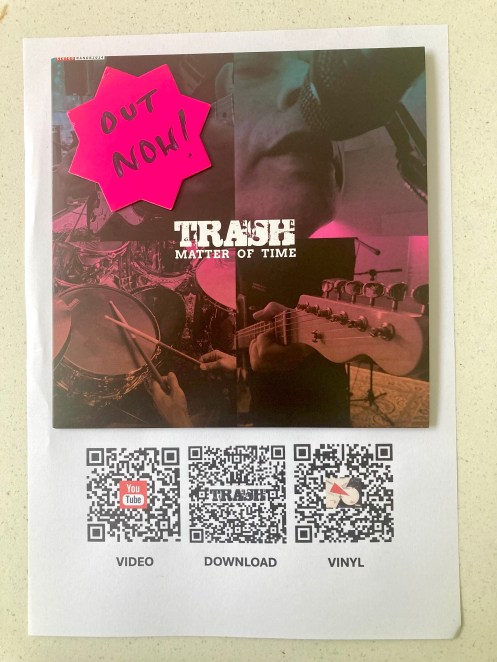
It’s been quite a week!

The Who / Level 42
Royal Albert Hall Teenage Cancer Trust benefit
March 27th
View: Right down the front
Having ditched their touring orchestra, the new seven-piece slimline version of The Who took advantage of their enhanced flexibility to open with a stream of stunning singles including I Can’t Explain, Substitute, Who Are You, Pinball Wizard, The Seeker and (best of all) I Can See For Miles. Four songs from Quadrophenia followed, whilst Who’s Next was represented by Bargain, Love Ain’t For Keeping, Behind Blue Eyes, Baba O’Riley and Won’t Get Fooled Again. Frontman Roger Daltrey was exuberant: Pete Townshend was more reserved but contributed effective lead guitar to complement his brother Simon’s rhythm parts. Drummer Zak Starkey was on stunning form throughout. Ending with an acoustic Tea and Theatre, Daltrey and Townsend again showed themselves to be rock’n’roll’s Odd Couple. Support Level 42 suffered dreadful sound but still went down well.
Review written for Record Collector magazine, who published this version:
